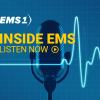Download this week’s episode on iTunes, SoundCloud or via RSS feed
In this week’s Inside EMS Podcast, hosts Chris Cebollero and Kelly Grayson talk with guest Kip Tietsort, at DT4EMS on managing violent patients.
They discuss two Glendale, Ariz. firefighters accused of using excessive force by swearing and punching a patient strapped to a gurney to defend themselves. Part of the scene was captured by a bystander’s cell phone video.
The firefighters were suspected without pay rather than fired because they had not been trained how to handle a violent situation. Fire Chief Mark Burdick said policy allows firefighters to protect themselves with any means necessary if police are not on scene.
“You can’t blame them if you don’t train them,” Tietsort said.
Emotion plays a huge role when it comes to violent patients, and assaults often start with a patient who is drunk or who has taken drugs, he said.
He stressed the importance of better giving EMTs and paramedics a better understanding around the issue of consent, and offering more training when it comes to handlilng situations with the potential to get out of control. EMS providers use role playing and critical thinking for medical skills like starting an IV, and the same concept needs to apply to violent patient management, Tietsort said.
“We brow beat our people to death with critical thinking skills to save someone else, but we’re not giving them critical thinking skills to save their own behind,” he said.
Violent patient management often comes to light in the media when there’s a major screw up or an EMS provider is threatened at gun point, but it happens every day, he said.
In the News
Speaking of emotions, Cebollero and Grayson also discuss an investigation into an EMT accused of storming out of the house while treating a man who was having a stroke. The man’s family said he got angry and sat in the ambulance until his partner went out and brought him back into the home to transport the patient.
“There are three sides to every story,” Cebollero said. “There’s my side, there’s your side and somewhere in the middle is the truth.”
Whatever actually happened, the incident is a black eye to the EMS career field, he added.
Grayson said we’ve all worked on a scene where a family gets upset and tensions are high.
“The way to handle such situations,” he said, “is not to stomp your foot and leave.”












